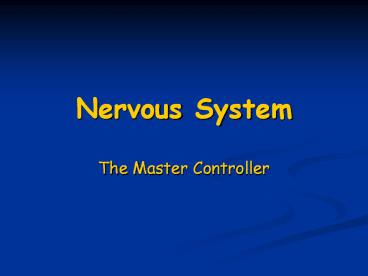Nervous System PowerPoint PPT Presentation
1 / 28
Title: Nervous System
1
Nervous System
- The Master Controller
2
Nervous System
Figure 11.1
3
Nervous System
- Functions
- Sensory input monitoring stimuli occurring
inside and outside the body - Integration interpretation of sensory input
- Motor output response to stimuli by activating
effector organs
4
Organization of the Nervous System
- Central nervous system (CNS)
- Brain and spinal cord
- Integration and command center
- Peripheral nervous system (PNS)
- Paired spinal and cranial nerves
- Carries messages to and from the spinal cord and
brain
5
Peripheral Nervous System (PNS) Two Functional
Divisions
- Sensory (afferent) division
- Sensory afferent fibers carry impulses from
skin, skeletal muscles, and joints to the brain - Visceral afferent fibers transmit impulses from
visceral organs to the brain - Motor (efferent) division
- Transmits impulses from the CNS to effector organs
6
Motor Division Two Main Parts
- Somatic nervous system
- Conscious control of skeletal muscles
- Autonomic nervous system (ANS)
- Regulates smooth muscle, cardiac muscle, and
glands - Divisions
- sympathetic
- parasympathetic
7
Histology
- The two principal cell types of the nervous
system are - Neurons excitable cells that transmit
electrical signals - Supporting cells cells that surround and wrap
neurons
8
Astrocytes
- Most abundant, versatile, and highly branched
glial cells - cling to neurons and their synaptic endings, and
cover capillaries - Functions
- Support and brace neurons
- Anchor neurons to their nutrient supplies
- Guide migration of young neurons
- Control the chemical environment
9
Astrocytes
Figure 11.3a
10
Microglia and Ependymal Cells
- Microglia small, ovoid cells with spiny
processes - Phagocytes that monitor the health of neurons
- Ependymal cells range in shape from squamous to
columnar - They line the central cavities of the brain and
spinal column
11
Microglia and Ependymal Cells
Figure 11.3b, c
12
Oligodendrocytes, Schwann Cells, and Satellite
Cells
Figure 11.3d, e
13
Oligodendrocytes, Schwann Cells, and Satellite
Cells
- Oligodendrocytes branched cells that wrap CNS
nerve fibers - Schwann cells (neurolemmocytes) surround fibers
of the PNS - Satellite cells surround neuron cell bodies with
ganglia
14
Neurons (Nerve Cells)
Figure 11.4b
15
Neurons (Nerve Cells)
- Structural units of the nervous system
- Composed of
- Body
- Axon
- dendrites
- plasma membrane functions in
- Electrical signaling
- Cell-to-cell signaling during development
16
Neurons
Figure 11.4b
17
Cell Body
- Contains the nucleus and a nucleolus
- Is the major biosynthetic center
- Is the focal point for the outgrowth of neuronal
processes - Has no centrioles (hence its amitotic nature)
- Has well-developed Nissl bodies (rough ER)
- Contains an axon hillock cone-shaped area from
which axons arise
18
Dendrites of Motor Neurons
- Short, tapering, and diffusely branched processes
- They are the receptive, or input, regions of the
neuron - Electrical signals are conveyed as graded
potentials (not action potentials)
19
Axons Structure
- Slender processes of uniform diameter arising
from the hillock - Long axons are called nerve fibers
- Usually there is only one unbranched axon per
neuron - Rare branches, if present, are called axon
collaterals - Axonal terminal branched terminus of an axon
20
Axons Function
- Generate and transmit action potentials
- Secrete neurotransmitters from the axonal
terminals - Movement along axons occurs in two ways
- Anterograde toward axonal terminal
- Retrograde away from axonal terminal
21
Myelin Sheath
Figure 11.5a-c
22
Nodes of Ranvier
- Gaps in the myelin sheath between adjacent
Schwann cells - They are the sites where axon collaterals can
emerge
23
Unmyelinated Axons
- A Schwann cell surrounds nerve fibers but coiling
does not take place - Schwann cells partially enclose 15 or more axons
24
Axons of the CNS
- Both myelinated and unmyelinated fibers are
present - Myelin sheaths are formed by oligodendrocytes
- Nodes of Ranvier are widely spaced
- There is no neurilemma
25
Neuron Classification
- Structural
- Multipolar three or more processes
- Bipolar two processes (axon and dendrite)
- Unipolar single, short process
26
Comparison of Structural Classes of Neurons
Table 11.1.2
27
Comparison of Structural Classes of Neurons
28
Comparison of Structural Classes of Neurons
Table 11.1.3

